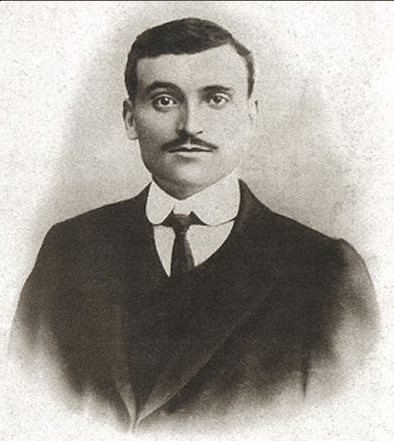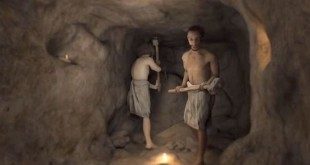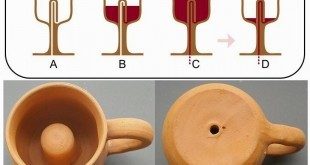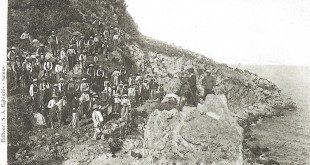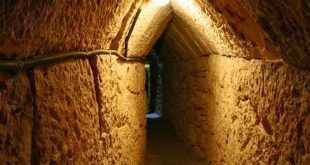“Antreas Kopasis was wounded nearby the Royal Palace in front of the Turkish guards and the regretful eyes of his exqisite partners Th. Anezinis, A. Alexandrou, Her. Thalassinos and the two Deputies, whom Nemesis had forced to see the end of the tyrants, the despots and the unconscious offenders of the human rights and to watch the last moments of a monster, which their allegiance enforced and infuriated against all the Samian people.
After shooting Kopasis, Stavros Baretis went away but the Turk cohort Katsoulis shot him in the groin. Although he was in pain, he managed to climb up the Vlamari and to take shelter in the Monastery of Agia Zoni.
Baretis lay down there for 24 hours. He was denounced either by a Th. Anezinis servant or by a frightened villager and got arrested by the Turkish press-gang. He was, then, sent to the Military Hospital in Vathi, and, either due to his wounds or due to the injuries caused by the rifles – especially by the ranger Geralexis – two days later, he suffered from appendectomy and passed away. He was already informed of Kopasis’ death.
This was the end of the four-year despotism of Antreas Kopasis, who had to resign to the unwritten law of nature and paid with his own blood the death as well as the pain and the sorrow he himself provoked to the island.
These are the descriptions Thrasibulos Mallis makes in his book “Samos under self-governing”, picturing the execution of the tyrant and the death of the tyrannicide fighter Stavros Baretis.
The proceedings of the 12th May 1908, when the Turkish army descended in the island, conflicted with armed Samian people, when thirty unarmed Samians, crossing near the the Royal Palace at that time, died, gave Kopasis the authority of absolute sovereignty.
(Mr. Angelos Rigas continues…)
In this notification, I will not describe the city, or Kopasis’ character and behavior towards the Samians. Before me, K. Ptinis in his book “The potentate of Samos” gives plenty of information about the Tyrant and his time. He reports that Kopasis was the most cultivated Tyrant, after Karatheodoris. Nevertheless, his culture did not prevent him from acting like a monster. The counsellor K. Garoufalis, in his book “Some things of those I heard and lived”,reports two characteristic events, which depict the temper of the man.
First was the case of Emm. Nikolaidis, an intelligent counsellor-at-law. He was accused of encroaching till from the Maurogeneio Occupational School because he refused to collaborate with Kopasis’ set-up. Emm. Nikolaidis was confined and tortured for months.
The second event is his proposal to F. Garoufali to the postulate of Prosecuting Attorney, in order to manipulate him and finally to confine Herakles Thalassinos to death. “The Tyrant ordered this criminal exchange, although he was Greek and Christian Orthodox,” reports K. Garoufalis. If he remained in authority, the Revolution, which Th. Sofoulis brew, would never be accomplished. The Turkish Revolutionary Committee would not recall him, despite the thorough rebellion. In the end, only the annihilation of the Tyrant Kopasis could lead the way to the revolution. The great sacrifice of S. Baretis, native of Kolchiko in Thessalonika, was the execution of the Tyrant through his own life; he brought freedom to Samos and united the island with the rest of Greece.
The injured “New Aristogiton” took shelter in the Monastery of Agia Zoni, as Th. Mallis cites. The abbot, Father Nikiforos and his sister Giasimo still remember the cited fact. The blood stains guided the outpost to the Monastery.
N. Melachrinides recited to Pavlos K. Papakonstantinou, that certain people were relegated to help S. Baretis after his shooting attempt against the Tyrant, however this mesh could not function properly as they were deceived that S. Baretis was injured to death. The chairman of Pagonda Chr. Maniatis or his counselor-at-law St. Maniatis waited equestrian by the Plane of the refugee residence unfruitfully. Either Baretis changed his way after the chasing, or Chr. Maniatis went away, at the rumor that S. Baretis was killed. Maybe other people assisted him to reach Agia Zoni, because his wound was very serious and the distance great and heavy.
I wanted to learn more about this man and his personality. one way was to read the papers of the time and catch on with the facts. I followed a different way. I wanted to learn the story through the acquaintances and the context in which S. Baretis was born and took action. So, I called at his village.
The clerk of the Community of Kolchiko, N. Stamboulis indicated me two papers and informed me of the bust of S. Baretis, which was erected in 1966. Furthermore, he spoke about Baretis’ kinfolks, who live in the village. The next day, I was acquainted with his brother’s son, his nephew, mr. Ioannis Kazantzi. We spoke on the telephone and we had a fascinating conversation. He asked me if I was a journalist and felt disappointed when I told him that I was a doctor.
He promised to send me notes, which I received soon through the Community. I should thank the clerk, N. Stamboulis for his assistance. But, we must allow I. Kazantzis talk about his great uncle:
“I am an 82 year old pensioner and my name is Ioannis Kazantzis. It is a great honor and a great opportunity to detail the facts that you ask me. My uncle, S. Baretis or Kazantzis, as you already know, was from Kolchiko, called Blaftsa at that time. He took the name Baretis, when he was delegated from the Greek Government to sail to Samos and annihilate the betrayer of our fatherland, the Turk and Tyrant of the Samian people, A. Kopasis.
Baretis was then –in 1906- a very competent man. He loved Greece greatly, especially Macedonia (the Land of Alexander’s). He was unfavorable to the Bulgars and Turks. He was classified in Ath. Stavroudis team, leader from Baltza, Melissochori. He also teamed up with Captain John Ramnoli.
The Greek Consulate sent him to the School of Army Cadets in Athens. Before even completing the courses, the Greek Government denounced Kopasis and Baretis volunteered to annihilate him. As far as I know, he killed Kopasis in March 1912. The Turkish guards in the Monastery of Agia Zoni, where he resorted wounded, arrested him. Kopasis did not die instantly; he lived enough time to command Baretis’ capture and ordered the cohorts to bring him alive.
At that time, while they beat Kopasis so that he would testify, as the Journal called “Agaion” reports, he passed away. Then, some familiar whispered in his ear that the Tyrant had died. Baretis spoke and said: “The betrayers of our fatherland shall, from now on, die this way”. He then breathed his last and the island of Samos stained with his blood. When prisoners heard that Kopasis was killed, broke the chains of the guardrooms and dashed out shouting ”up with Greece“, “up with Freedom” –those who were still in the mountains shouted the same acclamation.
The story of Baretis is very long, however no one, until this day, outlined Baretis in the story. He had many relatives. Our father was his brother. He had a sister and a second brother, four brothers and sisters in Toto. Not one of them was ever interested to present the story of Baretis, as they all were illiterate.
When I became forty years old, I was curious and felt that something had to be done. With the assistance of the headmaster of Langada, native of Kozani, the Mayor of Langada – shame, I cannot recall their names – and the help of our Community clerk Mr. Chrisostomos Kalaintzis, I was impelled to vivify Baretis name. Baretis’ bust was built at the center of our village, in 1966 at the General Army Staff expenses, and the Langadas camp took his name.
S. Baretis was engaged but as he followed the military way, he abandoned his fiancée and ordered one of his nephews to marry her. His will was accomplished. Baretis’ fiancée is my godmother; she baptized me and witnessed my marriage.
It is a great honor, that we are called nephews of Baretis. Every year all the people of our village celebrate the Macedonian Battle around his Bust.
Agathaggelos Fostiropoulos, seventeen years old then – high school student in Vathi, Samos-, provided me with some elements which I use in my today’s’ speech. He bore witness to the facts, delivered the mails from town to the mountains and back. He lived the dramatic days and completed his memories with these lines:
On the Macedonian Soldier S. Baretis or Kazantzis
Fearless, heroic brave fighter, you cut the Turkish beggar down.
You submitted youth and life, sacrificed on the Nation’s unique command.
Paid allegiance to the Macedonian ideal, died in Samos, in a warlord island.
Oh, unforgettable Stavros Baretis, sprout of Macedonia, the Land of Alexander’s, luminous star.
Ag. Fostiropoulos studied and became trainer. Later, as a pensioner, he lived in Thessalonica, 20, Doumbioti str. He met the Priest of our village, and the Priest acquainted me with him. Ag. Fostiropoulos died twelve years ago sightless.
P.S. a) The Seaport of Samos Island provided us with the Journal called “Agaion” of 1913, the date of the annual commemoration of Baretis, where all the historical facts considering the execution are reported.
B) A two-volume book concerning the Macedonian Battle illustrates the action of Baretis and of my father. At this point, the narration of the nephew of S. Baretis, G. Kazantzis, comes to an end.
At the community of Kolchiko, an S. Baretis curriculum vita illuminates his action:
Kolchiko, January 14th 1961
St. Baretis or Kazantzis
He was born in Blaftsa, renamed Kolchiko, in 1885 and was a farmer. In 1906, at the age of 21, he took part in the bloody Macedonian Battle. Due to the Bulgarian propagand, some families in Blaftsa, with Dimitrios Chatzis in command, took up for Bulgurs, co-operating in the Bulgarism of our Macedonia.
In 1907, with the assistance of Chariton Skara from Blaftsa and Christos Dremlis from Langada, he killed the Bulgur-friend Dimitrios Chatzis in the fields. After the Constitution Law of 1909, captain Baretis or Kazantzis himself killed, at the center of the Market, Vassilios Chatzis, son of Dimitrios, because he continued to collaborate with the Bulgurs, in an extremely provocative way, disremembering his father’s death.
After this homicide the Turkish Government put a price on his head and persecuted him. Under extremely dramatic circumstances, he took shelter in the Greek Consulate of Thessalonica. The Greek Consulate helped him to escape to Athens. At that time, the Commander of Samos Island was the Turcophile Antreas Kopasis. He was a very rough Tyrant. The Head Committee of the Greek Revolutionary Committee concluded to annihilate him relieving the poor Samians from his tyranny. They announced this decision to a group of chiefs. The first to surge and took the offensive was Stavros Baretis or Kazantzis.
The attached duplicate document from the Municipality of the Seaport of Vathi, with no. 1396155 July 1955, describes the facts having to do with the execution of the Tyrant:
From the Seaport of Vathi, 25th of July 1955
To the President of the Community of Kolchiko, County of Thessalonica With regard to your document numbered 143, we have the honor to inform you that, despite our time-consuming efforts – due to which our answer is so belated – we never managed to gather the below elements:
The Macedonian Revolutionary Committee in Athens consigned Stavros Baretis, native of your Community, with the mission to murder the Samian Tyrant Antreas Kopasis.
Indeed, he arrived to Samos Island as a tobacconist and, pretending to have a pseudo-name, he attained personal communication with the Tyrant, however he did not succeed to kill the man inside the Palace, as it was at first intended. He persisted in his heroic efforts and finally achieved iterative gunshot against the Tyrant, by the quay, near the building of the Bank of Athens. The injuries he provoked to the victim were fatal and after two days he succumbed.
Immediately after the gunshots, the ever memorable man Stavros Baretis, tried to escape, but was shot by the Tyrant cohort. Although he was injured, he managed to walk to the Agia Zoni Monastery, two km. away, where he received first aid. However, the bleeding wounds stained the way to the Monastery and guided the Turkish guards to his resort. He was arrested and carried away to the Military Hospital of Samos, where, despite the specialists’ efforts, he succumbed to his injuries.
The above authentic and brief story portrays the brave character of your ever-memorable fellow-townsman Stavros Baretis, a picture of whom has a special place in every house of the island.
A bust in his honor was never erected. The Mayor.
In Kolchiko of Thessalonica Baretis’ bust is erected, at the General Army Staff expenses. We, the Samian people, eighty-three years after the sacrifice of a man for our own sake, have paid our debt in his memory by giving his name to the coastal bystreet, where he was shot when he tried to avoid the execution.
P.S. (1) According to a prophecy of Agios Kosmas of Aitolia, Epirus would be redeemed from the Turks the year when two Easter celebrations coincided. It is proved that the year of 1912, when Epirus was set free, is the year of the prophecy. Kopasis’ execution by S. Baretis took place in the last Friday before Easter, celebrated on the 25th of March. Agios Kosmas of Aitolia predicted the date of the Greek Revolution and the date of the liberation of Epirus.
P.S. (2) In page 19, of the second volume of the book “Some things of those I heard and lived”, K. Garoufalis recalls: “…even with such delay, people must honour the unforgettable hero, and construct on his plain grave a marmoreal and glorious monument”.
Does the grave still exist? What is the opinion of the township of Vathi?
Angelos Rigas
 iSamos.gr Η ενημερωτική σελίδα της Σάμου! Εξερευνήστε τη Σάμο, τις παραλίες της, τη φύση της, τις ομορφιές της. Διαβάστε την ιστορία της Σάμου
iSamos.gr Η ενημερωτική σελίδα της Σάμου! Εξερευνήστε τη Σάμο, τις παραλίες της, τη φύση της, τις ομορφιές της. Διαβάστε την ιστορία της Σάμου

